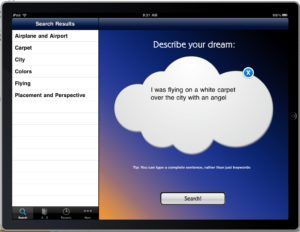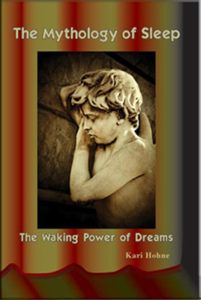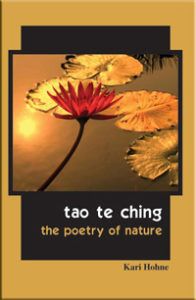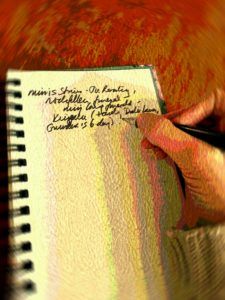Today, let’s explore how dreams and creativity work together, though an interview with Kari Hohne.
Accessing the 24 Hour Mind

“The 24 Hour Mind!” The first time I heard Kari Hohne mention the 24 Hour Mind, I made a doggy head-tilt. You know, a “What’s that?” kind of look.
I wanted to know more.
Although Kari started out as my client for a book proposal, she soon became a mentor for me in the dreamscape: helping me access the wisdom, intuition and the power of my dreams for increased creativity, more harmonious relationships and a breakthrough on my most recent book project.
Once I got the bug, I realized that my readers and clients could benefit greatly from what Kari teaches about the 24 hour mind, creativity, dreams, innovation and all of life, really.
Kari has been analyzing dreams for people all over the world for many decades, and pioneered the hero’s journey through the dreamscape. Kari writes about the three parts of every dream that show conflict, cause and resolution.
I’ve found in my work with Kari that the transformation that takes in my dreams often proceeds the personal transformation that follows in everyday life. Without further ado, here is our conversation about how to access the 24 hour mind for creativity, writing and life.
Lisa: Kari, you help people access their “24 Hour Mind.” What is the 24 Hour Mind and what does it open up for us?
Kari: The 24 Hour Mind describes the totality of the mind’s potential.
In ancient times, dreams were at the center of understanding one’s life path. Today, we’ve compartmentalized life and dreams as two separate mental processes and actually ignore half of the mind’s experience and expression.
The way dreams condense symbols in ingenious ways shows that each of us has access to enormous creativity and innovative thought that we underutilize.
Once people begin dreamwork, they always notice how synchronicity intensifies. Synchronicity is the sense that what we dream seems to precede what we experience. You might also call this sensation déjà vu.
I also noticed that dreams have a different time sense and a view of the life path that is not available to everyday consciousness. After observing how we are learning equally through experience and when we dream, it occurred to me that the eastern “all is me” view of experience is exactly the formula used for interpreting dreams.
Additionally, we spend almost half of our lives in the learning environment of dreams, and we are actually in a more enlightened and open condition when we are dreaming. By removing the illusion that we should have boundaries between the dream/wake/dream cycle, we access the part of our mind that is ingeniously creative, boundless and at the root of our intention.
We are more of a witness in dreams and if we can apply this same sort of wonder and non-attachment to our daily awareness, we can see how life is mirroring our intention back to us.
Through my series: The 24 HourMind, people can learn how to access intention and change it. The formula is inspired by how dreams are structured, but doesn’t require that we remember our dreams.
Intention and Potential, Dreams and Creativity
 Lisa: Of course, we all dream, even if we don’t remember our dreams and so we all have some access to the 24 Hour Mind, but you talk about being intentional.
Lisa: Of course, we all dream, even if we don’t remember our dreams and so we all have some access to the 24 Hour Mind, but you talk about being intentional.
How does intention help us gain greater access to our potential? How do our dreams and reality interact?
Kari: The images a mind uses to describe what’s happening in the inner world shows how the dreamer has organized reality. For example, bathrooms can show how a dreamer is attempting to ‘come clean’ and reveal their more intimate nature.
Lisa: We’ve certainly seen that image come up in my dreams!
Kari: A tree house can show how the dreamer is moving closer to their organic being or authenticity. And Trickster symbols like coyote…
Lisa: Or those toy dragons in my dreams!
Kari: Yes. Exactly. Tricksters can appear to allow a dreamer to laugh at their sense of certainty.
Immediately following a breakthrough dream, the police will show up as if the psyche has a sense that some repressed quality and the emerging enlightenment is ‘against the rules’ and off limits. The conditional tapes of childhood can be tough to erase through applied thought and meditation. Therefore, the dreamer’s potential is limited by these false assumptions and the mind’s self-imposed limitations.
All dream images capture snapshots to tell a story of what the dreamer’s mind either allows access to, or keeps as repressed potential. The correlation between dreams and experience is that the repressed ideas explored in dreams might shift a dreamer to open up to a new view of experience.
When this emerging awareness is being considered, synchronicity brings an event into actual experience where the same idea can be tested in reality. I laugh at the word reality because the 24 Hour Mind becomes aware of how life is an ongoing dream. It is one story unfolding in two dimensions, but it is the same story. These stories become the life we allow ourselves to live.
When we dismiss dreams, simply because we can’t understand their metaphorical language, we miss an awareness that would fast forward our ability to evolve into authenticity and achieve our greater potential.
If dreams are a way of viewing how we organize experience through intention, understanding these inner dynamics will allow us to change intention. By observing life as our ongoing dream, or as a reflection of our inner world, life reflects our intention back to us.
Building Self Help Technology and a Database of Ancient Eastern and Western Wisdom
 Lisa: You’re a wonderful example of the innovations that dreams can help you access (and the way dreams and creativity work together). Your Dream App has remained in the top 10 at Amazon and iTunes since its launch in 2009 and you’ve had over 100,00 downloads.
Lisa: You’re a wonderful example of the innovations that dreams can help you access (and the way dreams and creativity work together). Your Dream App has remained in the top 10 at Amazon and iTunes since its launch in 2009 and you’ve had over 100,00 downloads.
What are the secrets to your success with apps?
Kari: I think the same early adopters who embraced apps were also the type of people interested in tapping their personal technology to achieve greater efficiency. Understanding dreams is the key to unlocking greater human potential. Many of my apps began as books but I redesigned the information into fun platforms so readers can grab exactly what they need when they need it.
Way of Dreams allows you to type your dream into a cloud and it interprets it, while saving it to a diary. Inspired Natural Wisdom connects the spiritual journey to nature and many of the more than 150,000 people who visit Cafe Au Soul each month are green enthusiasts or those seeking to find meaning in a life connected to nature.
Dreams allows you to type your dream into a cloud and it interprets it, while saving it to a diary. Inspired Natural Wisdom connects the spiritual journey to nature and many of the more than 150,000 people who visit Cafe Au Soul each month are green enthusiasts or those seeking to find meaning in a life connected to nature.
Beyond the dream dictionary on my website, I also have the Internet’s most popular I Ching oracle. I’m launching the app in January. This oracle is also inspired by nature, which is the basis of Taoism. I build self-help technology, whether through apps or the many free oracles on my website so people can find a place to explore their inner direction. I see the I Ching as a culmination of eastern wisdom, while Tarot and Astrology are rooted in western archetypes.
Cafe au Soul is a virtual database of all of our collective and ancient wisdom.
Cultivating a Sense of Wonder with the 24 Hour Mind, Dreams and Creativity
Lisa: Wow, that’s a tall order. Let’s talk specifically about writers. We often rise in the morning in a creative state. Why is that? Should we always write immediately upon waking or are there other ways to tap into the subconscious mind?
Kari: I always say it is as if we have two minds. The daily mind is driven by cognition which is survival driven. It was designed to notice what’s wrong or out of place in the environment so that whatever is amiss, can be efficiently organized and classified so it can move on to its next task. Creativity is not cognition’s strong point.
The dreaming mind is more of a transcendent outlook which is completely boundless, and established on a foundation that anything is possible.
The same part of our mind that cleverly chose two unlike symbols to make a breakthrough point in a dream is more accessible after dreaming. When we awake from the metaphorical and boundless awareness and immediately shift back into cognition, the dream content is lost. It was the cognitive mind that buried the real story in the first place. This is why people have difficulty remembering their dreams.
Cognition can be retrained to behave more like the dreaming mind with its foundation of wonder. This is the core of what I teach about the 24 Hour Mind. To remove the barriers between the dream/wake/dream cycle, we have to look at our idea of the world and release our assumptions. Is what I believe real? Is what I have always believed as the only way, truly the only way? What if I juxtapose two different ideas? What if I allow synchronicity to add a bit of inspiration as a message and incorporate it into what I am writing?
Dreams inspire this creative approach: 1) Take two unlike things and combine them. 2) Change the order of the obvious. 3) Don’t discount the bizarre. 4) Be willing to be lifted out of your shoes!
The unnatural boundaries the mind creates can keep us stuck in routine thinking. If we want to be more creative we simply look at life as being no more real than a dream. What seems so tangible about life is really nothing different to how we believe dreams are real while we are dreaming. We hold the power to change our experiences. When the mind returns to wonder, anything is possible.
Dreams and Creativity: Writing and the Subconscious Mind
 Lisa: What’s the power of the subconscious mind? What does it do for our writing and creativity?
Lisa: What’s the power of the subconscious mind? What does it do for our writing and creativity?
Kari: I want to just clarify that cognition is an organizing tool and the unconscious holds an enormous reservoir of personal and collective inspiration. The subconscious holds ideas that are pre-conscious. These ideas are neither completely unconscious nor immediately available to consciousness.
For example, let’s say we have repressed something from childhood, perhaps a fear of being destitute or a shameful experience that now resides in the unconscious. In an attempt to fill this inner vacuum, we overcompensate by seeking accolades and become over achievers. Our subconscious triggers the experiences that validate our unconscious beliefs. The subconscious drives our focus and this is what we come to say is real.
When we begin to explore what’s repressed, we would describe the same activity as synchronicity because now intention is no longer unconscious and we can observe how we are drawing these experiences to prove our beliefs.
In the case of synchronicity – we have become open to change. The power of the subconscious mind is the trigger for how intention manifests. This part of the mind is often a barrier to how we might access unconscious potential and greater inspiration.
In dreams, we freely explore all aspects of the unconscious.
Archetypes are inspiration of a collective and transpersonal nature. So for writers, it is the unconscious that might allow for enormous inspiration once the barriers of the subconscious are transcended and cognition is coaxed toward wonder.
I use another idea from Taoism to help people move away from purely cognitive thinking. In the west, we associate the mind with all aspects of thought. The heart is the place where all feelings reside. In Taoism, intention resides in the heart mind. So one activity I give people while they are working on changing intention is to center themselves in the solar plexus, the home of the heart mind.
Our feelings infuse consciousness with a belief in what is possible. If we are afraid, angry, or beaten down by life, we perpetuate the experience with these feelings. As we center ourselves in the solar plexus – where thoughts are no longer just of the mind and feelings are no longer just of the heart – by simply taking a breath, we can clear our intention. No matter where we find ourselves in the stages of our transformation, and regardless of the experiences we encounter, we can change everything with a simple breath.
Prior to writing or embarking on any creative adventure, I would say 1) Move away from what you know. 2) Center yourself in the solar plexus. 3) Take a breath. 4) Hold to excited anticipation. 5) The outcome doesn’t matter because anything is possible and it will be perfect. You are the creator and have the power to create anything. Whatever you believe is true is true for you.
Lisa: That’s beautiful!
[bctt tweet=”Breaking Through Blocks through Dreamwork and the 24 Hour Mind” username=”LisaTener”]
Lisa: I was stuck for a long time in staying with a writing project of my own and I found that working with you on dreams and creativity caused a breakthrough in commitment and productivity. Is that common?
Kari: Yes. I’ve worked with many innovators, musicians, writers and healers and all have felt an increase in mental energy and focus because we got rid of the psyche’s barnacles. Those doing dream work always notice how enormous energy is released in the psyche, energy that was usurped by repression and how creativity blossoms. The greatest takeaway people get from doing dream work is the knowledge that they have this inner genius at their disposal. Knowing this changes the process of creating from work to an adventure of discovery. When we remove the subconscious blockages, it’s like opening a fire hose of creativity.
Lisa: I love reading your writing. It’s playful, often humorous, insightful and offers powerful information. How do you get into a state of flow? Is it just second nature? If so, was it always that way or how did you come to this place?
Kari: Thank you for saying that. I’ve learned so much from you, too. The creative process seems to work best when the artist is not centered in the self. This is demonstrated best in acting. When the actor completely transcends the sense of self and allows the character to have life within them, the audience is moved by an alter reality. The moment the actor becomes self-conscious, the process fails.
In writing too, the process of writing is more important than the product. We might have an idea of where we are going, but we have to allow for the opening of wonder…the belief that discovery translates to the reader…the freedom to be led by where our writing takes us.
Just as the Trickster in dreams is always poking fun at all of our serious attempts to be certain, we have to take our thoughts lightly and be open to criticism. One of the most humiliating things I ever experienced as a writer was at a writer’s conference in Washington D.C in 2007 when I first began writing books on dreams. A publisher listened to my pitch and said, “Dreams? Oh yeah, you’re from California.”
 A year later I made the book into a dream interpretation app and it sold in the top 10 at iTunes. The following year Amazon asked me to build it for Kindle. Who would have thought a day would come when a bookstore would go directly to an author?
A year later I made the book into a dream interpretation app and it sold in the top 10 at iTunes. The following year Amazon asked me to build it for Kindle. Who would have thought a day would come when a bookstore would go directly to an author?
It’s more important to stay true to your inspiration, regardless of who understands it. Whether I’m writing books, apps, music or designing technology, it’s a completely inspired process. Much of it comes from dreams and the other portion comes from synchronicity. I am open and I know it will be fantastic – whatever it is. It has nothing to do with me other than how I have to peddle it into a world of furry eyebrows and arms akimbo.
It takes courage to stand behind your work. Like the actor, when I make it about me the process can only fail. The discovery process and accessing the inspiration makes it fun. Having people write to share how my work has helped them connect with their sense of direction makes it infinitely rewarding. We’re all students of life and we’re lucky to part of the few who keep wonder and inspiration at our core.
Powering Your Writing from Your Dream State
Lisa: What are some ways authors can use their dream state for creative inspiration to power their writing?
 Kari: When I was writing the Mythology of Sleep each chapter was inspired by a dream. I had a sense that I was writing about the common archetypes of world mythology, but I would wake up with a symbol that once explored, set the stage for each chapter. At the same time, the dream themes and archetypes I was working on emerged through specific clients, exactly at the time I began each chapter. It was uncanny.
Kari: When I was writing the Mythology of Sleep each chapter was inspired by a dream. I had a sense that I was writing about the common archetypes of world mythology, but I would wake up with a symbol that once explored, set the stage for each chapter. At the same time, the dream themes and archetypes I was working on emerged through specific clients, exactly at the time I began each chapter. It was uncanny.
What really amazed me was how I wrote seven chapters of archetypes around the world and when I got to the eighth chapter, the mythology of China and the Pa Gua (the elements of nature at the root of the I Ching) embodied the 8 archetypes exactly.
Each proceeding chapter was captured in one of the 8 Pa Gua. For example, the Warrior was Chien, the active life force of yang. The Survivor was embodied in K’un, the receptive or yin force. The chapter about the Zealot and Trickster’s Medicine was captured perfectly by Chen, the Thunder. In fact, Tricksters or Heyokas are Thunder Beings. How is that possible?
The book wrote itself. I was just the scribe and conduit. Perhaps it was my belief that this is possible that allowed it to happen.
As a dream analyst, I give dreams the type of importance they deserve. The challenge is always remembering your dreams enough to allow them to inspire your work.
My suggested method for using dreams to write:
1) Keep a diary by your bed and be committed to capturing your inspiration.
2) Honor this inspiration as a gift of insight and use intention to remember.
3) Remember that cognition is the antagonist of the dream hero, so wake up gently.
4) Rather than trying to remember the dream, consider the feeling you are left with. This can jar your memory later.
5) In the final stage of sleep and while still using your dreaming mind, see if you can capture just one symbol. Name it. For some reason, the visual nature of dreams translated into a word allows it to be brought over to cognition without the normal defenses.
6) Take the symbol and research all you can about it and be open to seeing this symbol on your path. How can you apply it to your writing? The key to allowing this to happen for you will be your belief that it’s possible.
“Today’s reality is built on yesterday’s fantasy.”
Lisa: You’re a prolific creator—from one of the biggest downloaded dream apps on iTunes to your music to the pioneering work you did in the real estate industry in the early days of cell phone usage. Did your dreams always play a part in this creativity and success? How?
 Kari: It isn’t just dreams that fuel this creativity. I tap my 24 Hour Mind in that I don’t create barriers between what’s real and what’s fantasy. For an artist, fantasy is real.
Kari: It isn’t just dreams that fuel this creativity. I tap my 24 Hour Mind in that I don’t create barriers between what’s real and what’s fantasy. For an artist, fantasy is real.
Business innovators like Apple and Facebook aren’t necessarily selling products, they’re capitalizing on our desire for status. Is this real? Because I understand what dreams are doing to the mind, I know how to think this way all the time.
When I developed the first technology to allow homes to be viewed on the Internet and later on cell phones, it was a combination of looking at what’s possible and tweaking the system to make it happen. I had an idea, but had to push a lot of developers past their comfort zones to make it happen.
This is another aspect of the 24 Hour Mind. It doesn’t believe in boundaries. It sees beyond the need to classify what’s real and what’s fantasy because today’s reality is built on yesterday’s fantasy. Tomorrow’s fantasy can be real today. Why classify anything?
I like to use nature and physics in my writing because both show the unreality of our absolutes. After thousands of years of trying to understand our universe, nobody really knows anything and more than 80% of the universe is missing.
I know why we don’t remember our dreams, but I don’t understand how half of our life experience is dismissed as nonsense. We’re in a more enlightened state while dreaming and certainly more creative. I’m still not sold on the idea that what we call reality is any more real than what we are dreaming, except for the way cognition distances itself from the intention of the creator. So yes, dreams are the missing link in why we’re not able to access more of the mind’s potential.
Writers Who Tap Their Dreams and Creativity for Clarity
Lisa: Can you share some examples of nonfiction authors who’ve tapped into their dreams and creativity for clarity?

Kari: Einstein worked in a patent office and had dozed when he had the realization that a body falling in space has no mass, which helped him write his papers about gravity and relativity. He dreamed of sledding and seeing the stars differently, inspiring his writings about the speed of light and the universal constant.
Niels Bohr was working on the structure of the atom and dreamed of the nucleus of the atom with electrons spinning around it, similar to how planets spin around the sun, which led to him winning the Nobel Prize.
Descartes was inspired to devise the scientific method from a dream. Alfred Russel Wallace had a fever and in his delirious and semi conscious condition, the theory of evolution by natural selection came to him. Mendeleev felt he was close to seeing a pattern while assembling the periodic table but kept running into a wall. He was lucky in that he had a dream that spelled the entire table out for him. The saying to “sleep on it” comes from our common knowledge that, when working on solving an issue, we often wake up with the correct answer mysteriously.
It isn’t a mystery to me. We can use cognition to organize our ideas or to set a framework, but to allow our inner genius to achieve breakthrough thinking, it’s better to go for a run, clean the house or do something of a routine so cognition abates. There are numerous examples of how our greatest discoveries have come from dreams. The 24 hour mind doesn’t sleep.
Lisa: Can you give our readers a few steps to set intention and tap into the power of their dreams and creativity for their writing practice and ultimate success?
 Kari: I mentioned getting out of your head and moving more into a place of excited anticipation and discovery prior to writing. This is the head space achieved when working out and by getting in the ‘zone.’ We are in a state of energy rather than being consumed by life’s demands.
Kari: I mentioned getting out of your head and moving more into a place of excited anticipation and discovery prior to writing. This is the head space achieved when working out and by getting in the ‘zone.’ We are in a state of energy rather than being consumed by life’s demands.
I also recommend initially working with your dreams to understand and come to respect their incredible wisdom prior to just following the symbolism for inspiration. My examples of the insights that led to inventions can inspire readers to gather a sense of what type of inspiration they’d like to achieve prior to sleep. If the mind has spent the day organizing a set of ideas, sleep will spin it all around and reposition what’s most important. Out of the cauldron, a breakthrough symbol will come forward.
Lisa: You mentioned a free gift for our readers. What is it, where can they get it and how can it help them?
 Kari: I’d like to offer your readers a free introductory dream interpretation.
Kari: I’d like to offer your readers a free introductory dream interpretation.
Lisa: Wow, I have to admit I wasn’t expecting that, Kari. Your dream interpretation is amazing! What a generous gift.
Kari: My pleasure. I especially love working with creators. Your readers can contact me and mention this article. Readers can also download Affirmations Inspired by Nature, which allows you to search through challenges and listen to affirmations centered on how nature can inspire a more positive approach. It is a free and mini version of the more comprehensive Inspired Natural Wisdom that is includes a more detailed look at nature’s inspiring processes with a workbook.
Readers can also visit my website www.cafeausoul.com where I’ve combined technology with our ancient wisdom to make self-help an adventure.
Lisa: Thank you, Kari! We’ll all be waiting for your book with baited breath! In the meantime, you’ve shared a treasure-store of resources with us.
Readers, feel free to ask questions about Dreams, Creativity, Writing/Inspiration and the 24 Hour Mind, or share your experiences as a comment below.

